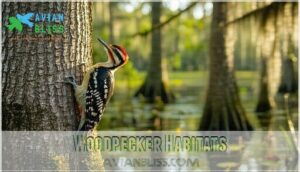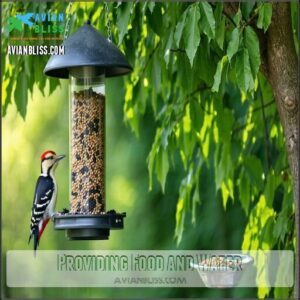This site is supported by our readers. We may earn a commission, at no cost to you, if you purchase through links.

The state hosts eight incredible species, from the tiny Downy to the massive Pileated.
You’ll find these feathered drummers in pine forests, urban woodlands, and backyard trees.
Red-bellied and Hairy Woodpeckers are common residents, while the endangered Red-cockaded Woodpecker calls specific forest habitats home.
Northern Flickers and Red-headed Woodpeckers add diversity to Alabama’s woodpecker landscape.
Each species has unique behaviors and habitats, making woodpecker watching an exciting adventure.
Want to know which trees attract these fascinating birds and their secret foraging techniques?
Table Of Contents
- Key Takeaways
- Alabama Woodpecker Species
- Woodpecker Habitats
- Woodpecker Diet and Foraging
- Attracting Alabama Woodpeckers
- Spotting Alabama Woodpeckers
- Frequently Asked Questions (FAQs)
- What is the most common woodpecker in Alabama?
- What does it mean when woodpeckers pecking at your house?
- Is it good to have woodpeckers in your yard?
- What does it mean when you see a woodpecker is pecking a tree?
- How do woodpeckers avoid head injuries?
- Do woodpeckers migrate during the winter?
- What predators commonly threaten woodpeckers in Alabama?
- How do woodpeckers impact local ecosystems?
- Can woodpeckers damage houses or property?
- What sounds do woodpeckers make?
- Conclusion
Key Takeaways
- You’ll find Alabama hosts eight unique woodpecker species, ranging from the tiny Downy to the massive Pileated, each adapted to thrive in diverse habitats from pine forests to urban woodlands.
- You can attract woodpeckers to your yard by creating bird-friendly spaces with native trees, strategic feeding stations, nest boxes, and reducing pesticide use, which supports local bird conservation efforts.
- You’ll discover that woodpeckers play critical ecological roles, from controlling insect populations to creating habitat for other species through their unique foraging and nesting behaviors.
- You can master woodpecker identification by learning their distinctive calls, observing their flight patterns, and understanding their habitat preferences across Alabama’s rich and varied landscapes.
Alabama Woodpecker Species
If you’re a bird enthusiast exploring Alabama’s diverse woodlands, you’ll be thrilled to discover eight unique woodpecker species that call this state home.
From the massive Pileated Woodpecker to the tiny Downy Woodpecker, these remarkable birds are waiting to be spotted in forests, parks, and even your backyard.
Downy Woodpeckers
Ever wondered who’s the tiniest drummer in Alabama’s woodpecker world? Meet the Downy Woodpecker, a pocket-sized marvel measuring just 5.5-6.7 inches long.
A tiny dynamo of the forest, the Downy Woodpecker proves that big drumming skills come in small feathered packages.
These feathered acrobats stand out with their distinctive characteristics:
- Crisp black and white plumage with checkered wings
- Males boasting a small red head patch
- Unique "pik" calls echoing through forest branches
- Remarkable ability to forage on thin branches other woodpeckers can’t access
Masters of adaptation, Downy Woodpeckers showcase incredible agility, hanging upside-down and traversing spaces larger woodpeckers can only dream about.
Their compact size and impressive skills make them true woodland champions.
Hairy Woodpeckers
If you thought Downy Woodpeckers were small, meet their beefier cousin!
Hairy Woodpeckers dominate Alabama’s tree trunks with bold black and white feather patterns.
Sporting a robust beak and distinctive red-orange male head patch, these woodpeckers of Alabama measure 7.1-10.2 inches long.
Their powerful calls and feeding habits make them backyard favorites, enthusiastically snatching suet and sunflower seeds.
Understanding woodpecker habitats is vital for attracting these birds to your yard.
Pileated Woodpeckers
After the modest hairy woodpecker, Alabama’s forest giant demands attention.
The pileated woodpecker commands respect with its dramatic 15.8-19.3-inch frame and fiery red crest.
You’ll spot these magnificent woodpeckers carving rectangular holes in mature trees, their distinctive calls echoing through woodland corridors.
Masters of their domain, they’re monogamous birds creating lasting bonds in Alabama’s rich forest ecosystems, embodying wild beauty and resilient survival.
Red-bellied Woodpeckers
After the dramatic drumming of the pileated woodpecker, you’ll likely notice a more subtle soundtrack from Alabama’s most common woodpecker species.
The red-bellied woodpecker announces its presence with a distinctive "churr-churr" call, turning ordinary backyard scenes into wildlife theaters.
- Spot their zebra-striped backs dancing across tree trunks
- Listen for their rhythmic, melodic woodpecker calls
- Watch their acrobatic foraging techniques
- Marvel at their year-round Alabama residency
- Admire their stunning red cap colors
These medium-sized birds sport a vibrant red crown extending from bill to nape, creating a mohawk-like silhouette. Measuring 9.4 inches long with a 13-16.5 inch wingspan, red-bellied woodpeckers feature black and white barred backs and a subtle pinkish-red belly.
Males and females look similar, with females displaying a more subdued gray forehead. Their adaptability makes them perfect for beginning birders seeking to explore woodpeckers of Alabama.
Red-cockaded Woodpeckers
While red-bellied woodpeckers populate Alabama’s landscape, their rarer cousin demands a more focused search.
Red-cockaded woodpeckers, an endangered species, carve unique territories in mature pine forests. These social birds live in tight-knit family groups, strategically excavating cavities in living pine trees with surgical precision.
You’ll spot these rare woodpeckers in select Alabama locations like Oakmulgee, Talladega, and Conecuh National Forests, where conservation efforts provide critical protection for their dwindling populations.
Their distinctive black and white barred plumage tells a story of survival, and is a key identifier for these birds in their natural habitat, making critical protection essential for their well-being.
Northern Flickers
In the heartland of Alabama, the Northern Flicker—the state’s beloved "yellowhammer"—dances across landscapes with distinctive charm.
Unlike typical woodpeckers, these ground-foraging birds boast brown-black barring, white-spotted breasts, and vibrant yellow wing patches.
Stretching 11-12 inches long, they’re an exemplar of Alabama’s rich woodpecker diversity, embodying unique Flicker behavior and migration patterns.
Red-headed Woodpeckers
As you venture through Alabama’s landscapes, the Red-headed Woodpecker catches your eye with its striking crimson crown and bold black-and-white plumage.
These aerial artists stand out among woodpeckers of Alabama with unique characteristics:
- Sharp "tchur" calls echo through woodland clearings
- Wingspan stretches an impressive 16.5 inches
- Nesting in dead trees and wooden structures
- Catching insects mid-flight with remarkable precision
Their population may have dwindled, but these feathered performers continue to captivate wildlife enthusiasts across the state with their striking appearance and unique characteristics.
Yellow-bellied Sapsuckers
Where red-headed woodpeckers hunt flying insects, yellow-bellied sapsuckers play a different game.
These winter visitors to Alabama tap maple and birch trees, drilling precise rows of sap wells.
Their unique woodpecker ecology revolves around strategic feeding patterns, creating sugar highways in tree bark.
Listen for their distinctive mewing calls—a hallmark of Sapsucker Migration through Alabama’s diverse woodlands.
Their tree selection and specialized foraging techniques make them fascinating members of Alabama’s woodpecker species.
Woodpecker Habitats
You’ll discover that Alabama’s woodpeckers thrive in diverse landscapes, from mature pine forests to suburban backyards.
Whether you’re exploring dense woodlands or walking through your neighborhood, these remarkable birds have adapted to inhabit a wide range of environments that offer plentiful trees, insects, and nesting opportunities.
Forest Types and Woodland Areas
Woodpeckers in Alabama find sanctuary across diverse forest landscapes, from towering longleaf pines to dense oak woodlands.
These feathered specialists have mastered survival in the state’s rich ecological tapestry.
- Longleaf pine ecosystems support specialized woodpecker populations
- Mixed deciduous forests offer complex foraging environments
- Cypress swamps provide unique nesting opportunities
- Mature forest stands host multiple woodpecker species
- Riparian zones create dynamic woodland corridors
Each woodland zone represents a carefully balanced ecosystem where woodpeckers play critical roles in forest ecology and woodland management. The presence of woodpeckers is often supported by effective bird feeder systems that enhance biodiversity.
The diverse forest landscapes and ecological tapestry of Alabama provide a unique environment for woodpeckers to thrive, making the state an ideal location for these feathered specialists to find sanctuary.
Urban and Suburban Areas
| Urban Feature | Woodpecker Preference | Habitat Strategy |
|---|---|---|
| Bird Feeders | Downy & Red-bellied | High attraction |
| Dead Trees | Multiple species | Foraging zones |
| Mature Trees | Hairy woodpeckers | Nesting sites |
| Wildlife Corridors | All species | Movement paths |
| Green Spaces | Varied populations | Survival hubs |
Urban landscapes offer surprising sanctuary for Alabama’s woodpeckers. Your backyard can become a thriving haven with strategic planning.
Intelligent design transforms residential areas into vibrant wildlife corridors, inviting these remarkable birds to make themselves at home.
Specific Trees and Plant Species
From bustling city parks to dense woodlands, Alabama’s tree diversity creates a woodpecker paradise.
These feathered carpenters find sanctuary in specific native trees:
- Longleaf pines host red-cockaded woodpeckers
- Oak species attract downy and red-bellied varieties
- Dead trees provide prime real estate for nesting
- Willow groves offer rich insect hunting grounds
Each tree type becomes a living ecosystem, welcoming these dynamic birds to drill, nest, and thrive in Alabama’s rich forest ecology, making them a key part of the state’s natural biodiversity.
Habitat Preferences by Woodpecker Type
Alabama’s woodpeckers dance to the rhythm of unique habitat preferences, each species carving out its niche in the state’s diverse landscapes.
Understanding their ecological blueprints helps you spot these winged wonders more easily.
- Imagine peering into dense pine forests where red-cockaded woodpeckers seek ancient trees
Deep in Alabama’s pine forests, rare red-cockaded woodpeckers carve their ancient tree sanctuaries with quiet determination.
- Feel the excitement of spotting a pileated woodpecker in mature woodland havens
- Discover downy woodpeckers thriving along woodland edges and backyard boundaries
- Listen for the distinctive drumming echoing through southeastern forest corridors
Red-cockaded woodpeckers demand mature pine forests, while pileated woodpeckers require dense woodlands with abundant dead trees. Downy woodpeckers adapt more flexibly, inhabiting forest edges and residential areas.
Tree selection and forest density play vital roles in Alabama woodpecker habitat preservation. The conservation of bird habitats is essential for maintaining biodiversity and supporting the coexistence of various woodpecker species.
Woodpecker Diet and Foraging
When you’re out birdwatching in Alabama, you’ll discover that woodpeckers are nature’s master foragers, tapping into trees and shrubs to feast on a diverse buffet of insects, fruits, and sap.
Their specialized beaks and unique hunting techniques allow them to extract nutrients from bark, branches, and even backyard feeders, making these incredible birds true survival experts in Alabama’s rich ecosystems.
Insects and Small Invertebrates
If you’ve wandered through Alabama’s woods, you’ve witnessed a remarkable bug-hunting symphony.
Woodpeckers prowl tree bark, extracting protein-packed invertebrates with surgical precision.
Their specialized tongues navigate ant colonies and probe bark crevices, revealing hidden insect larvae.
Pileated woodpeckers demolish carpenter ant nests, while downy woodpeckers target smaller prey nestled in branch networks.
Every precisely drilled hole tells a story of successful woodpecker foraging.
These feathered hunters transform trees into feeding grounds, transforming insect populations with each strategic peck.
During lean winter months, suet supplements become their lifeline, ensuring survival in the intricate ecosystem where bug capture means more than just a meal—it’s a battle for existence.
Fruits and Nectar
Woodpeckers’ versatile diets dance beyond insects, with fruits and nectar playing a vital role in their survival.
Your backyard can become a thriving woodland café for these feathered friends by offering:
- Native berry bushes like elderberry and blackberry
- Fruit slices on platform feeders
- Sugar water to attract nectar-loving species
Red-bellied woodpeckers, in particular, have a fruit-forward palate, consuming more berries than bugs throughout the year.
These dietary adaptations showcase their remarkable foraging skills, transforming seasonal fruit availability into a nutritional strategy across Alabama’s diverse ecosystems.
Seeds and Sap
Seeds and sap play a buffet-like role in woodpecker survival strategies.
These feathered foragers tap into nature’s pantry with remarkable precision, collecting tree sap and seeds across Alabama’s diverse landscapes.
| Food Source | Woodpecker Species | Seasonal Pattern |
|---|---|---|
| Tree Sap | Yellow-bellied Sapsucker | Spring Peaks |
| Black Seeds | Red-bellied Woodpecker | Year-Round |
| Suet Mixes | Downy & Hairy | Winter Preference |
Tree tapping becomes an art form for these birds, with specialized techniques allowing them to extract nutritious sap flows.
Their seed preferences vary by species, creating a complex dietary ecosystem that supports their incredible survival mechanisms in Alabama’s woodlands.
This ecosystem is crucial for the incredible survival mechanisms of woodpeckers, making their ability to adapt a key factor in their presence across Alabama.
Foraging Techniques and Strategies
Sifting through tree bark like nature’s master detectives, woodpeckers reveal stunning foraging techniques that’ll make you marvel at their survival skills.
Their hunt for survival involves more than meets the eye:
- Tree excavation uncovers hidden beetle larvae
- Aerial insect capture demonstrates lightning-fast reflexes
- Sap extraction creates precise wells in tree trunks
- Ground foraging targets ant colonies and fallen treats
- Specialized tongues probe deep into woody crevices
Each woodpecker species in Alabama has adapted unique hunting strategies.
Some snatch insects mid-flight, while others painstakingly drill through bark, revealing an intricate dance of survival that transforms ordinary trees into gourmet buffets.
Attracting Alabama Woodpeckers
Want to transform your backyard into a woodpecker paradise? Learn how strategic landscaping, specialized feeders, and habitat modifications can attract Alabama’s fascinating eight woodpecker species to your outdoor space.
Creating Woodpecker-Friendly Yards
Transforming your Alabama yard into a woodpecker sanctuary starts with strategic tree selection and habitat design.
Native oaks and pine trees provide essential woodpecker habitats, creating perfect nesting sites for local species.
Strategically place fallen branches near mature trees to encourage foraging, and embrace organic landscaping practices that support natural insect populations.
Skip harsh pesticides and focus on creating diverse, welcoming environments that mimic woodpecker-friendly Alabama woodland spaces.
Your thoughtful yard planning will attract these fascinating birds, turning your outdoor space into a thriving wildlife haven that supports woodpecker conservation efforts.
By incorporating native plants and woodpecker habitats, you can create an ideal environment for these birds to thrive.
Providing Food and Water
Every avid bird enthusiast knows that attracting woodpeckers requires a strategic feeding approach. Your backyard can become a woodpecker haven with the right provisions.
- Install suet feeders in shaded areas, offering a protein-rich feast for downy and hairy woodpeckers
- Scatter black sunflower seeds and peanuts on platform feeders to entice red-bellied visitors.
Maintain consistent year-round feeding stations, ensuring fresh water and diverse food sources that mimic their natural woodpecker diet. Using proper suet feeder designs can substantially enhance the feeding experience for these birds.
Installing Nesting Boxes
Attract local woodpeckers by strategically installing nest boxes designed to meet their unique needs.
Different species require specific box dimensions and placement techniques.
| Species | Box Size | Entrance Hole |
|---|---|---|
| Pileated | 8×8 inches | 3×3 inches |
| Red-headed | 6×6 inches | 2 inches |
| Yellow-bellied Sapsucker | 6×6 inches | 1.5 inches |
Mount boxes 10-20 feet high, using treated wood with proper ventilation.
Add wood chips inside and position away from direct sunlight.
Understanding proper woodpecker nest requirements is vital for success.
By creating inviting woodpecker habitats, you’ll support Alabama’s remarkable cavity-nesting birds and contribute to their conservation efforts.
Reducing Pesticide Use
When building your woodpecker-friendly backyard, ditching chemical pesticides can make a world of difference for Alabama’s winged residents.
Chemical-free pest control isn’t just good for woodpeckers—it’s a game-changer for local wildlife. Try organic alternatives like neem oil, companion planting, and beneficial insect encouragement.
These sustainable methods keep your garden healthy while providing a rich buffet of insects for woodpeckers. Native plants become natural pest management systems, supporting woodpecker conservation and creating vibrant habitats.
Your green approach transforms your yard into a sanctuary where Alabama’s eight woodpecker species can thrive, drill, and feast without toxic interruptions.
Spotting Alabama Woodpeckers
Ready to become a woodpecker-spotting pro? Your Alabama bird watching adventure starts by mastering woodpecker identification techniques.
Listen for distinctive woodpecker calls and watch for unique flight patterns that reveal each species.
Dawn and dusk offer prime woodpecker viewing times in forests and woodland edges. Look for telltale feather markers: red caps, black and white stripes, or distinctive wing bars.
Binoculars and a field guide will be your best companions when tracking these fascinating birds.
Different woodpecker species migrate through Alabama at various times, so timing matters.
With patience and keen observation, you’ll soon recognize the Red-bellied, Pileated, and Downy woodpeckers that call Alabama home.
Understanding woodpecker habitats is essential for effective spotting and conservation. Happy birding!
Frequently Asked Questions (FAQs)
What is the most common woodpecker in Alabama?
Hold onto your binoculars! The red-bellied woodpecker dominates Alabama’s forests, cruising through woodlands and backyards with its distinctive red cap and black-and-white barred wings.
It’s your most likely woodpecker encounter in the state.
What does it mean when woodpeckers pecking at your house?
When woodpeckers peck at your house, they’re likely searching for insects, marking territory, or attracting a mate.
Some might be creating nesting cavities or responding to potential prey hidden in your home’s siding, which could be related to the initial insects they are searching for.
Is it good to have woodpeckers in your yard?
When nature knocks on your door, woodpeckers can be both blessing and challenge.
They’ll help control insects, add wildlife charm to your yard, but might damage structures.
Choose prevention strategies to enjoy their presence without property harm.
What does it mean when you see a woodpecker is pecking a tree?
When you spot a woodpecker pecking a tree, it’s searching for tasty insects hidden beneath the bark or creating a cozy nest cavity.
This rhythmic drumming is their way of finding food and crafting a home.
How do woodpeckers avoid head injuries?
Imagine a feathered jackhammer pounding wood without a bruise.
Woodpeckers’ specialized skull bones, shock-absorbing tissues, and tiny brain size protect them from brain injury during intense pecking, thanks to remarkable evolutionary adaptations.
Do woodpeckers migrate during the winter?
You’ll find some Alabama woodpeckers stay put while others head south. The Red-bellied and Downy stick around year-round, but Yellow-bellied Sapsuckers migrate to warmer regions when temperatures drop.
What predators commonly threaten woodpeckers in Alabama?
You’ll face threats from hawks, owls, and snakes lurking in Alabama’s forests.
Domestic cats and raccoons also prey on woodpeckers, targeting their nests and young.
Staying vigilant helps you survive these woodland predators.
How do woodpeckers impact local ecosystems?
You’ll help woodpeckers maintain forest health by controlling insect populations, creating habitat for other species, and dispersing seeds while acting as ecosystem indicators through their unique foraging and nesting behaviors.
Can woodpeckers damage houses or property?
Yes, woodpeckers can damage your home by drilling holes in wood siding, fascia boards, and wooden structures while searching for insects or creating nesting cavities.
Potentially causing costly repairs if left unchecked.
What sounds do woodpeckers make?
Listen up, nature’s drummers are striking their rhythm!
Woodpeckers tap out sharp, staccato drumbeats on trees, create loud "peek" and "churr" calls.
They communicate through rapid-fire pecking that echoes like a forest’s heartbeat.
Conclusion
Ultimately, Alabama’s woodpeckers are like time-traveling ornithological detectives, revealing intricate ecological stories through their drumming rhythms.
You’ll discover eight fascinating species waiting to be observed across diverse landscapes.
By understanding their habitats, diets, and behaviors, you’ll become a skilled woodpeckers of Alabama enthusiast.
Your backyard, local forests, and urban woodlands offer unexpected opportunities to connect with these remarkable birds.
Stay curious, patient, and attentive – nature’s winged drummers await your discovery.








